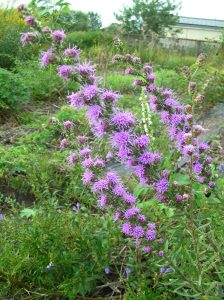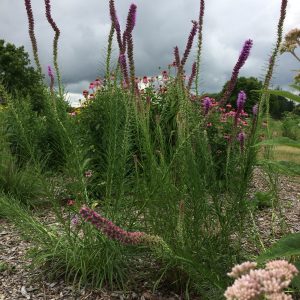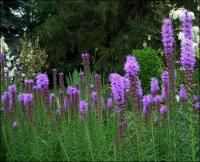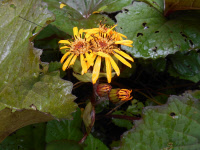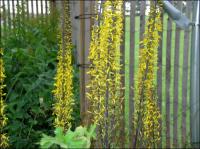Perennials & Biennials
Showing 273–280 of 485 results
-
Leucanthemum x superbum syn. Chrysanthemum x superbum Shasta Daisy
June – July classic white daisy hybridized by Luther Burbank.
June – July classic white daisy hybridized by Luther Burbank.
Size: 36” x 24”
Care: Sun - part shade in moist well-drained moderately fertile soilHybridized by Luther Burbank, the “plant wizard” during 17 years of intermittent work from 1884 – 1901. Quadruple hybrid made from the oxeye daisy, 2 European daisies and 1 Japanese daisy. Burbank introduced more than 800 plants. Named “Shasta” because the white petals reminded Burbank of the snow on top of California’s Mount Shasta.
-
Liatris aspera Rough blazing star Z 4-9
Feathery purple buttons along tall spikes August-October
OUT OF STOCK
Feathery purple buttons along tall spike in late summer: August-October
Size: 24”-30” x 12”-18”
Care: Sun in well-drained soil
Native: So. Canada, much of eastern 3/4th of U.S., Wisconsin Native
Wildlife Value: attract butterflies (favorite nectar for Monarchs and Buckeyes) & hummingbirds.Aspera is Latin meaning rough. 1st collected by Frenchman André Michaux (1746-1802) who spent 11 years in America collecting hundreds of new plants.
-
Liatris pycnostachya Prairie blazing star Z 3-9
Tall, erect, purplish- pink spike in August-September
OUT OF STOCK
Tall, erect, purplish- pink spike in August-September
Size: 4’ x 1-2’
Care: well-drained soil in full sun
Native: central & SE US
Wildlife Value: deer resistant, attracts birds, butterflies, and beesCollected by French planthunter Andre Michaux in 1795 on the prairies of Illinois. About 9 years later collected on the Lewis & Clark Expedition in South Dakota September 1804
-
Liatris spicata Blazing star, Gayfeather, Button snakeroot Z 3-8
Rosy purple spikes in July and August, a flower arranger’s dream
Rosy purple spikes in July and August, a flower arranger’s dream
Size: 2-3' x 18"
Care: Full sun in moist to well-drained soil.
Native: Eastern and southern U. S., Wisconsin native
Wildlife Value: favorite nectar source for Buckeye butterflies & host for caterpillars of Painted lady, Fritillaries, Skippers, Sulphurs, Coppers & Checkerspot butterflies.Native Americans used roots medicinally for backaches, colic, dropsy and to strengthen a weak heart. The Dakota recognized L. spicata as an indication “when the flower is blue-red that corn is good to eat.” Nicollet Diary, August 13, 1838. The dried root reputedly repelled moths from stored clothes. First collected by English naturalist Mark Catesby (1683-1749) and cultivated since 1732. Grown at America’s 1st botanic garden, Elgin Botanic Garden 1811.
-
Ligularia dentata In China called chi ye tuo wu, Leopard plant, Summer ragwort Z 3-8
Its leaves are as ornamental as its blooms – leaves are large, leathery, round with jagged margins and prominent veins; orange-yellow daisies, bloom in mid-summer
Its leaves are as ornamental as its blooms – leaves are large, leathery, round with jagged margins and prominent veins; orange-yellow daisies, bloom in mid-summer
Size: 3-4’ x 2-3’
Care: shade to part shade in moist to moist well-drained soil
Native: China & Honsu in JapanDentata refers to the jagged leaf edges. Collected and introduced to Europe by Carl Peter von Thunberg (1743-1828), student of Linnaeus at Uppsala University in Sweden. He made three trips to the Cape of Good Hope 1772-1775 where he collected about 1000 new species, Java and Ceylon (Sri Lanka) 1777 and 15 months in Japan (1775-1777) where he befriended local doctors who gave him hundreds of plants new to Western horticulture. He succeeded Linnaeus as professor of medicine and botany at Uppsala. Knighted by Swedish King Gustav.
-
Ligularia japonica syn. Ligularia kaempferi syn. Farfugium japonicum Leopard plant
Cutleaf bold foliage, golden yellow-orange daisy-like flowers in late summer
OUT OF STOCK
Cutleaf bold foliage, golden yellow-orange daisy-like flowers in late summer
Size: 4’ x 12”
Care: part shade in moist, fertile soil
Native: Japan, China & KoreaCollected and grown in the West before 1841. July 6 1872 The Garden reported that it bloomed in London.
-
Ligularia przewalskii syn. Senecio przewalskii Leopard plant Z 4-8
Bold, deeply palmate lobed foliage, deep yellow spike in late summer
Bold, deeply palmate lobed foliage, deep yellow spike in late summer
Size: 5-6' x 24-36"
Care: full to part shade in moist soil.
Native: Northern ChinaNamed for Nikolai Przewalski (1839-1888), Polish geographer and naturalist who explored Central Asia on behalf of Russia. First described in Bulletin de l’Academie Imperiale des Sciences de St-Petersburg, sér. 3 26(3): 493. 1880.
-
Ligularia siberica Z. 3-8
Spikes of yellow daisies atop a clump of bold, round leaves from June to August
OUT OF STOCK
Spikes of yellow daisies atop a clump of bold, round leaves from June to August
Size: 3-4' x 2’
Care: sun to shade in moist soil
Native: from France to JapanThis species in gardens before 1750. It was the 1st species of the genus, named by Linnaeus in 1753. Father of perennial borders, William Robinson: “Fine leaved and worth growing.” L.H. Bailey: “Said to be a showy marsh plant.”


